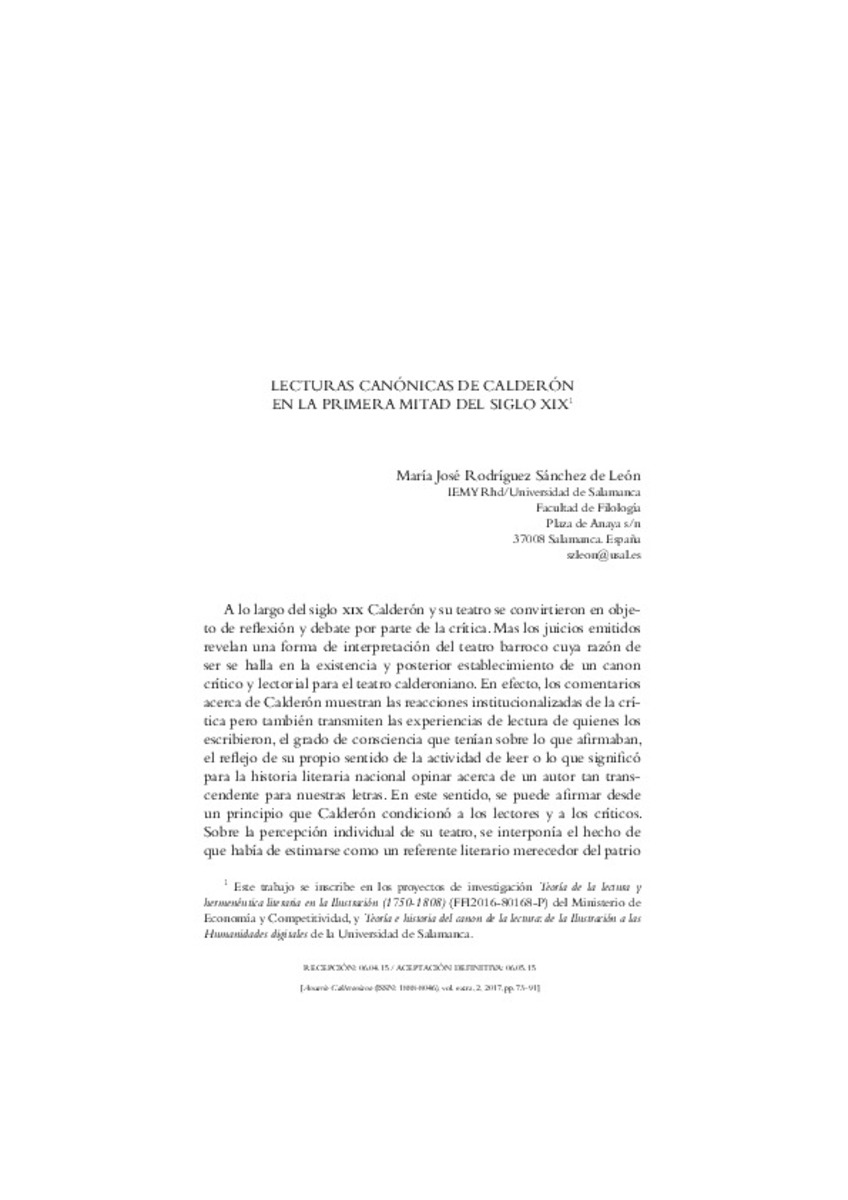Full metadata record
| DC Field | Value | Language |
|---|---|---|
| dc.creator | Rodríguez-Sánchez-de-León, M.J. (María José) | - |
| dc.date.accessioned | 2019-10-18T07:04:11Z | - |
| dc.date.available | 2019-10-18T07:04:11Z | - |
| dc.date.issued | 2017 | - |
| dc.identifier.citation | Rodríguez Sánchez de León, María José, «Lecturas canónicas de Calderón en la primera mitad del siglo XIX», Anuario Calderoniano, vol. extra, 2, 2017, pp. 73-91. | es_ES |
| dc.identifier.issn | 1888-8046 | - |
| dc.identifier.uri | https://hdl.handle.net/10171/58321 | - |
| dc.description.abstract | En este trabajo se analiza la diversidad de criterios con los que en la primera mitad del siglo XIX se valoró el teatro de Calderón y la diferente concepción de canónico o modélico que se atribuyó a su obra dramática. Se realiza así un recorrido explicativo de los comentarios que suscitó para comprobar cómo, cuándo y por qué se convirtió en un canon, en qué sentido se le canoniza (poético, dramático, ideológico, religioso, moral), y también cómo se transformó ese canon a lo largo del siglo XIX por razones tanto de evolución del arte como de la utilización de un autor representativo de la literatura española para justifi car el respeto a la tradición literaria nacional sobre la base de la aceptación de un sentido del progreso poético y político de las naciones. El artículo se inicia estudiando cómo la imaginación poética calderoniana se eleva a la categoría de cualidad nacional de índole artística o ético-religiosa según los críticos. Se continúa con los planteamientos que exigen su relativización estético-política en función de la historia y como ello conlleva una canonización moral. Ello plantea el conflicto entre la estatización del canon o su dinamización en la historia y por la historia. | es_ES |
| dc.description.abstract | This study analyses the diversity of criteria with which the plays by Calderón were assessed during the first half of the 19th century, and the different classification as canon or model to which his dramatic works were ascribed. We present an explanatory review of the comments to which his works gave rise in order to observe how, when and why they became part of the canon, in what sense they were canonized (poetically, dramatically, ideologically, religiously, morally), and also how that canon was transformed throughout the 19th century. This transformation took place both on the grounds of the evolution of art and of the use of an author who was representative of Spanish literature to justify the respect for national literary tradition based on the acceptance of a sense of poetic and political progress of nations. The article starts by analysing how the poetic imagination of Calderón is granted the category of a national artistic or ethical/religious feature, according to the critics. It continues by studying the approaches that required its aesthetic/political relativization depending on history, and how this fact implies a moral canonization. This, in turn, leads to the conflict between a static canon and a canon which is dynamic as part of history and because of history. | es_ES |
| dc.language.iso | spa | es_ES |
| dc.publisher | Iberoamericana/Vervuert | es_ES |
| dc.rights | info:eu-repo/semantics/openAccess | es_ES |
| dc.subject | Materias Investigacion::Filología y Literatura | es_ES |
| dc.subject | Calderón de la Barca | es_ES |
| dc.subject | teatro del Siglo de Oro | es_ES |
| dc.subject | crítica | es_ES |
| dc.subject | canon | es_ES |
| dc.subject | imaginación | es_ES |
| dc.subject | antiguos y modernos | es_ES |
| dc.subject | tradición literaria | es_ES |
| dc.subject | theatre of the Spanish Golden Age | es_ES |
| dc.subject | criticism | es_ES |
| dc.subject | canon | es_ES |
| dc.subject | imagination | es_ES |
| dc.subject | Ancients and Moderns | es_ES |
| dc.subject | literary tradition | es_ES |
| dc.title | Lecturas canónicas de Calderón en la primera mitad del siglo XIX | es_ES |
| dc.type | info:eu-repo/semantics/article | es_ES |
| dadun.citation.endingPage | 91 | es_ES |
| dadun.citation.startingPage | 73 | es_ES |
| dadun.citation.volume | extra, 2 | es_ES |
Files in This Item:
Statistics and impact
Items in Dadun are protected by copyright, with all rights reserved, unless otherwise indicated.






